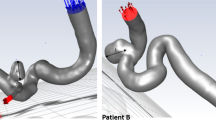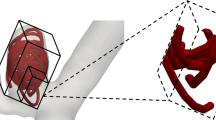Abstract
Introduction
Computational fluid dynamics (CFD) is a numerical technique that is used for studying haemodynamic parameters in cerebral aneurysms. As it is now possible to represent an anatomically accurate intracranial aneurysm in a computational model, we have attempted to simulate its endosaccular occlusion with coils and demonstrate the haemodynamic changes induced. This is the first attempt to use this particular porous medium-based method for coiling simulation in a CFD model, to our knowledge.
Methods
Datasets from a rotational 3-D digital subtraction angiogram of a recently ruptured anterior communicating aneurysm were converted into a 3-D geometric model and the discretized data were processed using the computational technique developed. Coiling embolisation simulation was achieved by impediment of flow through a porous medium with characteristics following a series of embolisation coils. Haemodynamic parameters studied were: pressure distribution on the vessel wall, blood velocity and blood flow patterns.
Results
Significant haemodynamic changes were detected after deployment of the first coil. Similar, but less dramatic changes occurred during subsequent stages of coiling. The blood flow patterns became less vortical in the aneurysm sac as velocity decreased to stagnation and the wall pressure at the fundus was gradually reduced. Furthermore, the haemodynamic characteristics developed at the area of the neck remnant could form the basis for assessing the likelihood of delayed coil compaction and aneurysm regrowth.
Conclusion
Appropriate computational techniques show great promise in simulating the haemodynamic behaviour of the various stages in coil embolisation and may be a potentially valuable tool in interventional planning and procedural decision-making.






Similar content being viewed by others
References
Butty VD, Gudjonsson K, Buchel P, Makhijani VB, Ventikos Y, Poulikakos D (2002) Residence times and basins of attraction for a realistic right internal carotid artery with two aneurysms. Biorheology 39:387–393
Steinman DA, Milner JS, Norley CJ, Lownie SP, Holdsworth DW (2003) Image-based computational simulation of flow-dynamics in a giant intracranial aneurysm. AJNR Am J Neuroradiol 24:559–566
Castro MA, Putman CM, Cebral JR (2006) Patient-specific computational modelling of cerebral aneurysms with multiple avenues of flow from 3D rotational angiography images. Acad Radiol 13:811–821
Burleson AC, Strother CM, Turitto VT (1995) Computer modelling of intracranial saccular and lateral aneurysms and the study of their haemodynamics. AJNR Am J Neuroradiol 37:774–784
Cebral JR, Castro MA, Burgess JE, Pergolizzi RS, Sheridan MJ, Putman CM (2005) Characterization of cerebral aneurysms for assessing risk of rupture by using patient-specific computational hemodynamics models. AJNR Am J Neuroradiol 26:2550–2559
Jou LD, Wong G, Dispensa B, Lawton MT, Higashida RT, Young WL, Saloner D (2005) Correlation between luminal geometry changes and haemodynamics in fusiform intracranial aneurysms. AJNR Am J Neuroradiol 26:2357–2363
Shojima M, Oshima M, Takagi K, Torii R, Hayakawa M, Katada K, Morita A, Kirino T (2004) Magnitude and role of wall shear stress on cerebral aneurysm: computational fluid dynamic study of 20 middle cerebral artery aneurysms. Stroke 35:2500–2505
Acevedo-Bolton G, Jou L-D, Dispensa BP, Lawton MT, Higashida RT, Martin AJ, Young WL, Saloner D (2006) Estimating the haemodynamic impact of interventional treatments of aneurysms: numerical simulation with experimental validation: technical case report. Neurosurgery 59:E429–E430
Aenis M, Stancampiano AP, Wakhloo AK, Lieber BB (1997) Modeling of flow in a straight stented and nonstented side wall aneurysm model. J Biomech Eng 119:206–212
Jou LD, Quick CM, Young WL, Lawton MT, Higashida R, Martin A, Saloner D (2003): Computational approach to quantifying haemodynamic forces in giant cerebral aneurysms. AJNR Am J Neuroradiol 24:1804–1810
Hassan T, Ezura M, Timofeev EV, Tominaga T, Saito T, Takahashi A, Takayama K, Yoshimoto T (2004): Computational simulation of therapeutic parent artery occlusion to treat giant vertebrobasilar aneurysm. AJNR Am J Neuroradiol 25:63–68
Koponen A, Kataja M, Timonen J (1997) Permeability and effective porosity of porous media. Phys Rev E 56:3319–3325
Achenbach E (1971) Influence of surface roughness on the cross-flow around a circular cylinder. J Fluid Mech 46:321–335
Ujiie H, Liepsch DW, Goetz M, Yamaguchi R, Yonetani H, Takakura K (1996) Hemodynamic study of the anterior communicating artery. Stroke 27:2086–2094
ESI Group (2006) CFD-ACE users manual. ESI Group Huntsville, AL
Piotin M, Mandai S, Kieran J, Sugiu K et al (2000) Dense packing of cerebral aneurysms: an in vitro study with detachable platinum coils. AJNR Am J Neuroradiol 21:757–760
Kawanabe Y, Sadato A, Taki W, Hashimoto N (2001) Endovascular occlusion of intracranial aneurysms with Guglielmi detachable coils: correlation between coil packing density and coil compaction. Acta Neurochir (Wien) 143:451–455
Byrne JV, Sohn MJ, Molyneux AJ, Chir B (1999) Five-year experience in using coil embolization for ruptured intracranial aneurysms: outcomes and incidence of late rebleeding. J Neurosurg 90:656–663
Cognard C, Weill A, Spelle L, Piotin M, Castaings L, Rey A, Moret J (1999) Long-term angiographic follow-up of 169 intracranial berry aneurysms occluded with detachable coils. Radiology 212:348–356
Raymond J, Guilbert F, Weill A, Georganos S, Juravsky L, Lambert A, Lamoureux J, Chagnon M, Daniel Roy D (2003) Long-term angiographic recurrences after selective endovascular treatment of aneurysms with detachable coils. Stroke 34:1398–1403
Murayama Y, Nien YL, Duckwiler G, Gobin YP, Jahan R, Frazee J, Martin N, Vinuela F (2003) Guglielmi detachable coil embolization of cerebral aneurysms: 11 years' experience. J Neurosurg 98:959–966
Vinuela F, Duckwiler G, Maward M (1997) Guglielmi detachable coil embolization of acute intracranial aneurysms: perioperative anatomical and clinical outcome in 403 patients. Neurosurg 86:475–482
Horowitz MB, Purdy PD, Burns D, Belloto D (1997) Scanning electron microscopic findings in a basilar tip aneurysm embolized with Guglielmi detachable coils. AJNR Am J Neuroradiol 18:688–690
Byun HS, Rhee K (2004) CFD modelling of blood flow following embolisation of aneurysms. Med Eng Phys 26:755–761
Groden C, Laudan J, Gatchell S, Zeumer H (2001) Three-dimensional pulsatile flow simulation before and after endovascular coil embolization of a terminal cerebral aneurysm. Cereb Blood Flow Metab 21:1464–1471
Bedekar AS, Pant K, Ventikos Y, Sundaram S (2005) A computational model combining vascular biology and haemodynamics for thrombosis prediction in anatomically accurate cerebral aneurysms. Food Bioprod Process 83(C2):118–126
Author information
Authors and Affiliations
Corresponding author
Additional information
Conflict of interest statement
We declare that we have no conflict of interest.
Part of this work was the subject of the first author’s thesis for his Master of Science in Interventional Neuroradiology (University of Oxford, 2006) and part of it was presented as an oral presentation at the European Society of Neuroradiology Symposium (ESNR 2006 - Geneva).
Rights and permissions
About this article
Cite this article
Mitsos, A.P., Kakalis, N.M.P., Ventikos, Y.P. et al. Haemodynamic simulation of aneurysm coiling in an anatomically accurate computational fluid dynamics model: technical note. Neuroradiology 50, 341–347 (2008). https://doi.org/10.1007/s00234-007-0334-x
Received:
Accepted:
Published:
Issue Date:
DOI: https://doi.org/10.1007/s00234-007-0334-x




